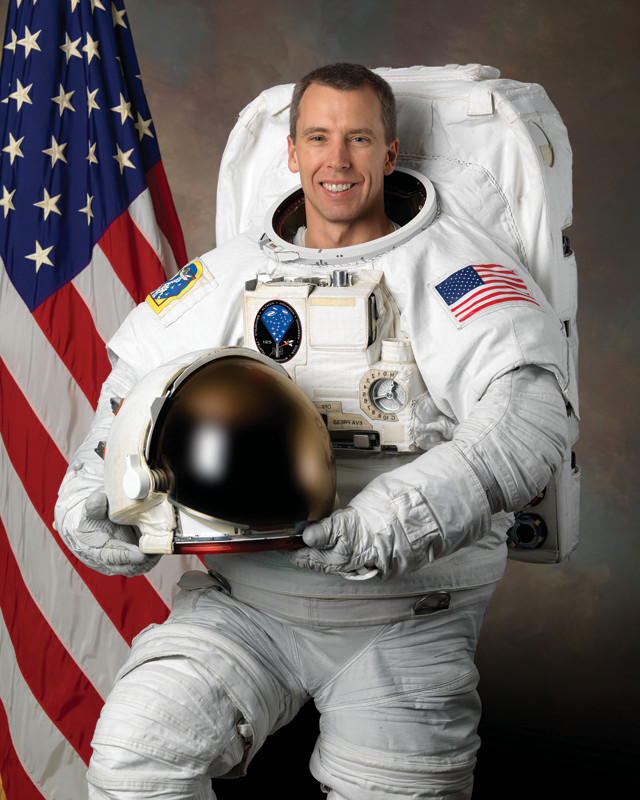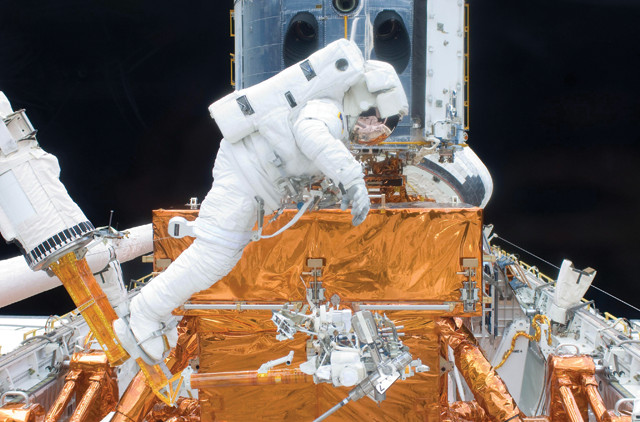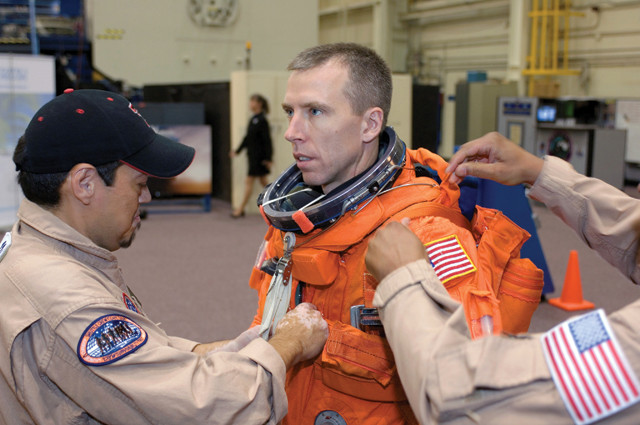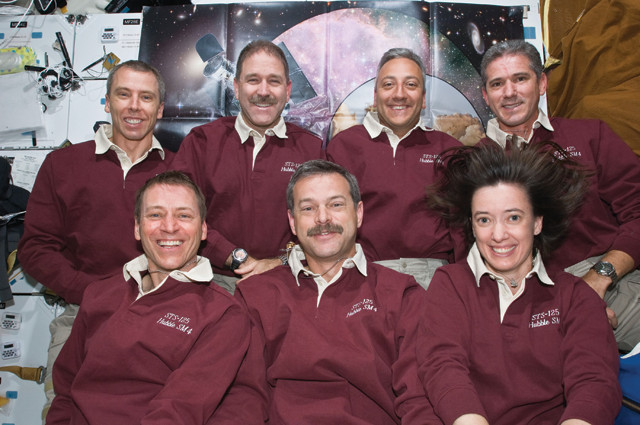
by Carolyn Gramling Tuesday, May 22, 2018

Astronaut Andrew Feustel was a mission specialist on the fifth and final Hubble Space Telescope repair mission (STS-125) in May 2009. Credit: NASA
Feustel’s academic career has taken several interesting turns, which sometimes brought him close to spaceflight — but never quite there, at least not until recently. After community college, he went on to study geology and geophysics as an undergraduate and master’s student at Purdue University in West Lafayette, Ind. — a school that happens to have a long history of graduating future astronauts. He then headed to Canada to pursue a doctoral degree, investigating seismic wave attenuation in underground mines at Queen’s University in Kingston, Ontario. In 1997, he went to Houston, Texas — coincidentally the location of NASA’s Johnson Space Flight Center, where astronauts train — to work for ExxonMobil as an exploration geophysicist. Even then, Feustel says, he still didn’t have a conscious plan to be an astronaut.
“None of those things make sense, from the standpoint of becoming an astronaut, at least if you consider what shuttle astronauts do,” Feustel told NASA in 2008 during a preflight interview. “We don’t do a lot of geology from the space shuttle. We’re operators of spacecraft.”
But Feustel says he always thought, in the back of his mind, that there would be a way to combine his mechanical and scientific interests. He sometimes even thought about what it would be like to bring those interests together in space, on the moon or on Mars.
After obtaining a pilot’s license, Feustel began two years of astronaut training in 2000. Then, in May 2009, he traveled on his first mission — as a mission specialist on the fifth and final space shuttle mission to repair the Hubble Space Telescope. During the nearly two-week spaceflight, Feustel took three spacewalks to repair some of the telescope’s ailing instruments.
In July, he takes off again, this time to the International Space Station to deliver a new state-of-the-art cosmic ray particle physics detector called the Alpha Magnetic Spectrometer. Meanwhile, when he’s on the ground, Feustel is still a car mechanic — in his home garage. Recently, EARTH’s Carolyn Gramling talked with Feustel about the twists and turns his career has taken on his way out to space.
CG: Before becoming an astronaut, you took what seems like an unusual path — at least to anyone who’s seen “The Right Stuff” or “Apollo 13,” or might think of astronauts as a space-oriented team of Air Force officers. How did you decide that this is what you wanted to do?
AF: It was just something that I always aspired to do. When I was young, I envisioned that when I grew up, it would be a normal thing for people to have access to space exploration. That’s obviously not the case, but it’s a track I put myself on. It’s also important to note that the astronaut office is 50 percent military and 50 percent civilian — there are a lot of folks who have done the same thing, been a scientist or engineer and ended up as an astronaut.
CG: You did a doctoral dissertation in mining seismology and later worked for ExxonMobil as an exploration geophysicist. Then you entered the astronaut program. What drew you to all of these different fields?

Feustel selects a tool to use for a hands-on repair of the Hubble Space Telescope during one of his three spacewalks. Credit: NASA
AF: I didn’t really have a plan for any of this. It was more about doing things that I could do well and that I enjoyed. For example, the decision to leave Ontario and come to Houston was more of an overall career choice to try the opportunities offered by Exxon. I thought that being in Houston would be a short-term plan. I didn’t think we would stay. [Laughs] But now it’s become a 12-year-or-more plan. Being an astronaut was not part of the initial decision to come to Houston. It was in my mind, but I didn’t have a long-term plan for how I would get into the astronaut corps.
CG: Back in your student days, you worked as a car mechanic restoring 1950s Jaguars. Since then, you’ve studied industrial design, thought about being an automotive designer and even been Grand Prix Chairman and a team go-kart driver for your fraternity at Purdue. As a geophysicist, you’ve also installed microseismic monitoring equipment in underground mines. Can you draw any parallels between these diverse interests and being an astronaut?
AF: It’s all “hands-on” work — a desire to understand mechanical systems and how things work. Spaceflight hardware has a lot of complex mechanical components, and my experience working with automobiles has helped significantly in my career.

Feustel dons a training version of his shuttle launch and entry suit at NASA's Johnson Space Center. Credit: NASA
CG: You’ve been on one mission so far — the final space shuttle mission to repair the Hubble Space Telescope. How’d you get selected for that mission?
AF: It’s tough to say. A lot of it is when it’s your turn and what opportunities are out there. Some of my skills as a mechanic and hands-on geophysicist also helped. What we did on Hubble was all about repairing the telescope, and the tool side of the work was pretty straightforward for me. It improved my situational awareness for the rest of the mission — the ability to think about other things. For example, instead of thinking about “how does this tool work?” I’m considering how I’m going to position myself. It expands your awareness of your work area.
CG: What do you do when not in space?
AF: I have my own garage — there’s always a project in there. I have a couple of cars in the garage now, and I support go-kart racing for my kids. I still try to work on mechanical things.
CG: What do you think will be the future of manned space missions in the United States and around the world? Or rather, what do you hope it will be?
AF: It’s really tough to say, and we’re all waiting for direction on that. The government and people of our country and around the world support human space exploration; the challenge that we have now is how to direct funds between national security, social programs, space. We’re all in favor of future exploration past the low-Earth orbit and getting back to the moon — we’re working on surface exploration objectives and the potential of seismic exploration on the moon when we return. I’m personally interested in going to the moon. I’m trying to stay involved in the design and development.
We are destined to explore other planets in our solar system. But we’re at a very early stage. I grew up thinking we were going to be George Jetson by now, but we’re still Fred Flintstone. There’s a lot of work to do.

Feustel (upper left) with the rest of the crew from the STS-125 Hubble repair mission. Credit: NASA
CG: You did three spacewalks on the Hubble mission. I have to ask: What was your first spacewalk like?
AF: It was everything I imagined. There’s a great amount of excitement when you’re first coming out of the door. The views of Earth are just spectacular from space. It’s a very calming experience, floating freely, just the visor between you and the vacuum of space.
© 2008-2021. All rights reserved. Any copying, redistribution or retransmission of any of the contents of this service without the expressed written permission of the American Geosciences Institute is expressly prohibited. Click here for all copyright requests.